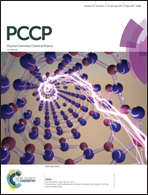On the accuracy of the general, state-specific polarizable-continuum model for the description of correlated ground- and excited states in solution†
Abstract
Equilibrium and non-equilibrium formulations of the state-specific polarizable-continuum model (SS-PCM) are evaluated in combination with correlated ground- and excited-state densities provided by the algebraic-diagrammatic construction method (ADC) for the polarization propagator via the computationally efficient intermediate-state representation (ISR) formalism. Since the influence of the SS-PCM onto quantum-chemical method is naturally limited to the presence of the apparent surface charges in the one-electron Hamiltonian and hence fully contained in the polarized MOs, the herein presented solvent model can be combined with all implemented orders and variants of ADC. Employing ADC/SS-PCM, the symmetric, ionized dimers of neon, ethene and nitromethane are investigated. Their broken-symmetry wavefunctions exhibit a low-lying charge-transfer state that is symmetry-equivalent to the ground state. This curious though ultimately artificial feature is convenient as it allows for a direct comparison of ADC/SS-PCM for the CT state to the Møller–Plesset/PCM description of the ground state. The agreement down to 0.02 eV for a wide range of dielectric constants validates the ADC/SS-PCM approach. Eventually, the relaxed potential-energy surfaces of the ground and lowest excited states of 4-(N,N)-dimethylaminobenzonitrile in cyclohexane and acetonitrile are computed, and it is demonstrated that the ADC(2)/SS-PCM approach affords excellent agreement with experimental fluorescence data. Only at the ADC(3) level of theory, however, the experimentally observed solvent-dependent dual fluorescence can be explained.


 Please wait while we load your content...
Please wait while we load your content...